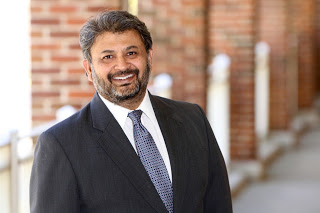Personal Column: Five myths about reopening schools and what we need to do right now
Sunil Dasgupta is one of the two final candidates for the At-Large seat on the Montgomery County Board of Education in the November 2020 election.
The final decision on reopening MCPS lies with the county’s chief health officer. The Board of Education’s role—and mine, as a prospective member—is to tirelessly plan for the moment the light turns green. Rather than emphasize careful and transparent planning and identifying needed resources, MCPS has contributed to anxiety and confusion. That, and poor communication, has led to five myths about school reopening.
Myth #1: Schools are safe and ready for return. Several questions need answers. What are the protocols for temperature checking, testing, contract tracing, distancing, and staff substitution? Who will assume school health responsibility, given that not every school has its own nurse? Who will determine which classrooms are usable, given known ventilation problems? Who will train staff in health protection?
What we must do: MCPS needs to work with families, educators, and other county agencies to address these questions before setting a reopen date. We cannot repeat what happened this past fall—where the educational plan was approved just days before school reopened.
Myth #2: Teachers stand in the way of reopening. Every single teacher I know—out of several hundred—wants to be back safely in their classrooms. According to Board member Judith Docca (District 1), 100 teachers voluntarily served on MCPS reopening “design teams” this summer despite a labor impasse and no contract. I spoke with many teachers who served—all felt their concerns were ignored.
What we must do: Teachers bring education to our students. Instead of alienating them, MCPS must make educators true partners. It is time to come to a contract agreement and support and engage teachers so they can provide the best possible education for our students.
Myth #3: Low-income families will choose return over safety. No family wants to send their children to unsafe schools, including low-income minority families disproportionately impacted by the pandemic. Like all families, they, too, will weigh the risk against their circumstances.
What we must do: Honor individual family and educator choices. I have proposed a detailed census of student/staff return preferences. Respondents should be able to update their choices, offering an accurate, evolving picture. Previous MCPS surveys had no responses from some zip codes and multiple entries from certain families. More on census/planning: https://bit.ly/2SLesO6.
Myth #4: Virtual learning is an across-the-board failure. Many students have succeeded in online learning; many others are struggling mightily. Some students are moving faster through coursework, and even some special needs families say their children thrive away from classroom distractions.
What we must do: This variability could have been—and can still be—addressed with better planning, manageable student and teacher workloads, and pedagogical and technological support. We need a true reimagining of our school day, including project-based lessons that do not require continuous screen time. Many teachers have excelled with little support. Imagine how much better things might be if educators help, planning, and training.
Myth #5: Our kids are falling behind. This is a concern, but falling behind whom? Private schools? Fairfax County in Virginia? Other states or countries? The pandemic is global. India, for example, is seeing a surge, and schools are closed. Many European countries are struggling. The worst outcome is sickness and fatalities. The academic and athletic losses are the second-to-worst. Incredibly, students have been creative and dogged, despite changing plans, curricula, platforms, and tech failures.
What we must do: Shift our expectations. In facing enormous challenges, the COVID Generation has shown resilience not seen in a long while. We have now lost half the number of people to COVID-19 as we lost in World War II. The generation that came of age during that terrible time lost learning, missed proms and celebrations, did not play football, and took school buses to work in factories. I know the COVID Generation will lead us out of this mess and help resolve enduring problems—such as climate change, racism, and inequality.
Show comments
Comments
No comments.
Please ensure that all comments are mature and responsible; they will go through moderation.
